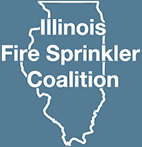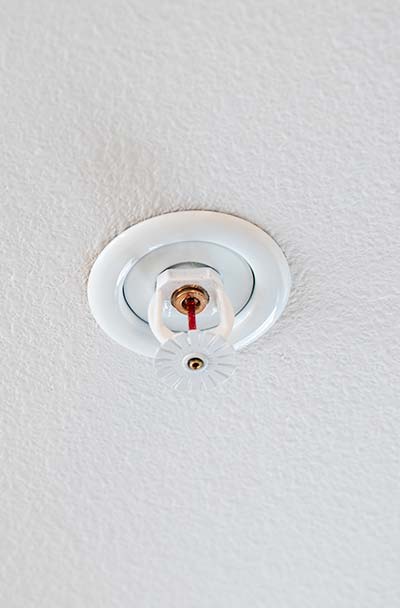HOME FIRE
SPRINKLER FACTS
Why home fire sprinklers are in
the national codes.
Since 2009, every model building code requires home fire sprinklers in new construction single-family homes including the International Residential Code (IRC) and NFPA 1, 101 Life Safety Code and 5000. Since sprinklers are a requirement of the model codes, not an option, if a new home is built according to code, but without sprinklers, the home should be considered substandard.
Model Codes 2006 NFPA 2009 ICC.
- Research conducted by Underwriters Laboratories (UL) and the National Institute of Standards and Technology (NIST) concluded that fires in newer homes burn faster and are deadlier compared to fires in older homes because of the materials used in new construction, the design of new homes (open concept), and the furniture and contents (Kerber, S. 2011).
- Lightweight construction materials used to build new homes burn faster and fail sooner. (Laminated and glued beams.) A 2006-10 Reuters report showed firefighters responded to 1300 incidents where lightweight construction hampered their ability to suppress fire.
- New homes are built to be airtight to meet energy-efficiency requirements and often feature open plans that can cause fire to flash and spread quickly. Polyurethane foam-filled furniture and other synthetic objects found in homes cause billowing, poisonous smoke. The UL and NIST research findings concluded that fire can become deadly in less than five minutes compared with almost 30 minutes in homes of the past (time is short).
- ISO’s Building Code Effectiveness Grading Schedule (BCEGS) reduces the points a community can score under the program if the community adopts the latest national code with an amendment such as eliminating the fire sprinkler requirement. Failure to adopt the residential sprinkler code adopted by the IRC could result in a loss.
- The National Flood Insurance Program’s Community Rating System takes a community’s BCEGS classification into account in developing a classification used in determining the premium for flood insurance.
- FEMA/ICC Model Code Adoption.
Codes and ordinances that require fire sprinklers in new construction single-family homes do not affect housing starts or economic growth.
- According to the National Association of Home Builders (NAHB) Building Permits by State Data (July 2017), from July 2016 to July 2017:
- Housing permits increased nationally with a YTD change of 11%.
- California and Maryland have state level codes that require fire sprinklers in all single-family home construction. Building permits were above the national average in both states:
-
- California permits: 18% YTD increase.
- Maryland permits: 14% YTD increase.
-
- While Illinois’ YTD permit change is below the national average with a 4% increase, northern Illinois where the 100+ towns with ordinances requiring sprinklers is higher than the state average with a 6% increase.
Data from municipalities with home fire sprinkler requirements support life- and property-saving benefits.
- Scottsdale, Arizona implemented NFPA 13D ordinance January 1, 1986. After 15 years:
- 50% of housing stock protected with fire sprinklers (50,000 homes)
- 598 home fires, 49 in sprinklered homes
- No deaths in sprinklered homes
- 13 people died in homes without sprinklers
- Less water damage in sprinklered homes
- Sprinkler systems discharged an average of 341 gallons of water/fire
- 2,935 gallons of water/fire were released by firefighter hoses
- Less fire damage in sprinklered homes
- Average fire loss per sprinklered incident: $2,166
- Average fire loss per unsprinklered incident: $45,019
- Prince Georges County, Maryland implemented NFPA 13D ordinance in 1992. After 15 years:
- 13,494 home fires, 245 in sprinklered homes
- No deaths in sprinklered homes
- 446 occupants were in structures during fire sprinkler activations
- 101 deaths and 328 injuries in homes without sprinklers
- Less fire damage in sprinklered homes
- Average fire loss per sprinklered incident: $4,883
- Average fire loss per unsprinklered incident: $9,983 and $49,503/fatal incident
- No deaths in sprinklered homes
- 13,494 home fires, 245 in sprinklered homes
- Bucks County, Pennsylvania, six municipalities implemented NFPA 13D ordinances. Between 1988-2010:
- 6,931 sprinklered homes
- 90 deaths in unsprinklered homes, 5 successful activations
- Less fire damage in sprinklered homes
- Average fire loss per sprinklered incident: $14,000
- Average fire loss per unsprinklered incident: $179,896
- 6,931 sprinklered homes
Homeowner value sprinklers once they understand the life-saving benefits.
- In a survey of 1,000 homeowners, 78 percent said sprinklers provide the ultimate fire protection and 74 percent were more likely to buy a home with sprinklers once they learned the facts (Harris Poll: HFSC, 2014).
- In a study to determine the value of sprinklers, 75 percent of people who lived in sprinklered homes and knew the facts said they were more likely to buy a home with sprinklers in the future versus 30 percent of people who did not know the facts (Frattaroli et al. 2015).
Every time a home is built without fire sprinkler protection, it is a lost opportunity to protect residents and firefighters for decades.
- According to the real estate industry, the main factor that determines property values is location. Numerous factors affect the value of existing residential property. The fact that a residential sprinkler ordinance improves public fire safety, while at the same time reduces the cost of providing public fire protection, should increase the value of existing residential property due to lower municipal governmental costs.
- According to the Fire Protection Research Foundation (2013), the national average to install fire sprinklers in a home is 1% to 2% of the total construction cost. California and Maryland with state codes saw a decline in installation costs since demand for sprinklers was so might (NFPA 2017).
- In Bucks County, Pennsylvania, there was no impact to ongoing residential development in the six communities that adopted fire sprinkler ordinance. In some of these communities, home building accelerated after the sprinkler ordinances were enacted. Builders and homeowners had a choice in which of the county’s 54 municipalities to construct new homes, and clearly, the residential sprinkler requirements in the six communities did not deter homebuilders from investing almost $815 million in these communities, and buyers from purchasing almost 7,000 sprinklered homes (Bucks County Report, 2011).
- If the cost of a fire sprinkler system were directly added to the home sales price, the impact on monthly payments is insignificant after credits that reduce home insurance costs and mortgage related tax deductions.
Home fire sprinklers play an important role in Community Risk Reduction (CRR) because they protect residents and firefighters.
- The very young, very old, and people with disabilities are at highest risk of dying in a house fire (NFPA 2016). Smoke alarms are important because they warn occupants when there is smoke, but occupants must have the skills, knowledge and ability to escape the structure on their own. Compared to a fire sprinkler, smoke detection cannot address the growth, impact or control of the fire incident because it is only a local, primary notification process (Scottsdale Report).
- Firefighters are more than 11 times more likely to be injured fighting structure fires; residential structures accounted for 67% of their injuries (USFA).
- Firefighters are increasingly vulnerable to contamination-related cancers and other disease. Home fire sprinklers minimize responder exposure, reducing contamination and injury by keeping fires small and preventing flashover and structural collapse.
- ISO’s Homeowners Policy Program Manual allows insurers to grant a discount of up to 13% on the insurance premiums for homes protected with fire sprinklers.
- ISO’s Building Code Effectiveness Grading Schedule (BCEGS) reduces the points a community can score if a community adopts the latest national code but eliminates requirements such as fire sprinklers. This affects the ISO rating, insurance rating, and insurance ratio for the community.
- The National Flood Insurance Program will not reimburse a community’s citizens at 100 percent if the community adopted a model code but deleted certain sections.


